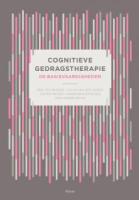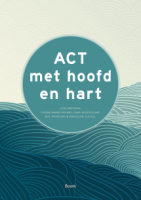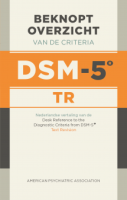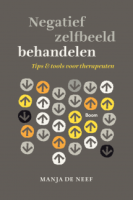Inhoud
Repetitief negatief denken en psychische klachten bij kinderen en adolescenten
Samenvatting
In deze bijdrage wordt de empirische ondersteuning voor de rol van verschillende vormen van repetitief negatief denken (te weten piekeren, emotiegericht rumineren en stressreactief rumineren) in de ontwikkeling van depressieve klachten bij jongeren samengevat. Resultaten laten zien dat alle vormen van negatief denken sterk samenhangen met depressieve klachten bij jongeren van 10 tot 18 jaar. Wanneer echter rekening wordt gehouden met initiële depressieve klachten is de invloed van negatief denken op depressieve klachten bescheiden, wat vragen oproept over de aard van de relatie tussen negatief denken en depressie. Het geringe aantal experimentele studies tot dusver uitgevoerd wijzen in de richting van een causale relatie tussen negatief denken en depressie bij jongeren. Naast het veranderen van de negatieve inhoud van gedachten is het veranderen van het denkproces een belangrijk aandachtspunt voor de behandeling van stemmingsklachten bij jongeren. In plaats van proberen negatieve denkprocessen een halt toe te roepen, zouden interventies zich kunnen richten op het veranderen van een abstracte verwerkingstijl in een concrete verwerkingstijl.
Literatuur
- Abela, J.R.Z., Parkinson, C., Stolow, D., & Starrs, C. (2009). A test of the integration of the hopelessness and response styles theories of depression in middle adolescence. Journal of Clinical Child and Adolescent Psychology, 38, 354-364.
- Alloy, L., Abramson, L., Hogan, M., Whitehouse, W., Rose, D., Robinson, M., et al. (2000). The Temple-Wisconsin cognitive vulnerability to depression project: Lifetime history of axis I psychopathology in individuals at high and low cognitive risk for depression. Journal of Abnormal Psychology, 109, 403-418.
- American Psychiatric Association (2000). Diagnostic and statistical manual of mental disorders (5th ed.). Washington, DC: APA.
- Borkovec, T.D., Ray, W.J., & Stöber, J. (1998). Worry: A cognitive phenomenon intimately linked to affective, physiological, and interpersonal behavioral processes. Cognitive Therapy and Research, 22, 561-576.
- Borkovec, T., Robinson, E., Pruzinsky, T., & DePree, J. (1983). Preliminary exploration of worry: Some characteristics and processes. Behaviour Research and Therapy, 21, 9-16.
- Burwell, R., & Shirk, S. (2007). Subtypes of rumination in adolescence: Associations between brooding, reflection, depressive symptoms, and coping. Journal of Clinical Child and Adolescent Psychology, 36, 56-65.
- Ehring, T. & Watkins, E.R. (2008). Repetitive negative thinking as a transdiagnostic process. International Journal of Cognitive Therapy, 1, 192-205.
- Ehring, T., Zetsche, U., Weidacker, K., Wahl, K., Schönfeld, S. & Ehlers, A. (2011). The Perseverative Thinking Questionnaire (PTQ): Validation of a content-independent measure of repetitive negative thinking. Journal of Behavior Therapy and Experimental Psychiatry, 42, 225-232.
- Hankin, B.L. (2008). Stability of cognitive vulnerabilities to depression: A short-term prospective multiwave study. Journal of Abnormal Psychology, 117, 324-333.
- Hankin, B.L. (2009). Development of sex differences in depressive and co-occurring anxious symptoms during adolescence: Descriptive trajectories and potential explanations in a multi-wave prospective study. Journal of Clinical Child & Adolescent Psychology, 38, 460-472.
- Harvey, A., Watkins, E., Mansell, W., & Shafran, R. (2004). Cognitive behavioral processes across psychological disorders: A transdiagnostic approach to research and treatment. Oxford: Oxford University Press.
- Moberly, N.J., & Watkins, E.R. (2006). Processing mode influences the relationship between trait rumination and emotional vulnerability. Behavior Therapy, 37, 281-291.
- Moberly, N.J., & Watkins, E.R. (2008). Ruminative self-focus and negative affect: An experience sampling study. Journal of Abnormal Psychology, 117, 314-323.
- Muris, P., Fokke, M., & Kwik, D. (2007). The ruminative response style in adolescents: An examination of its specific link to symptoms of depression. Cognitive Therapy and Research, 33, 21-32.
- Muris, P., Roelofs, J., Meesters, C., & Boomsma, P. (2004). Rumination and worry in non-clinical adolescents. Cognitive Therapy and Research, 28, 539-554.
- Nolen-Hoeksema, S. (1987). Sex differences in unipolar depression: Evidence and theory. Psychological Bulletin, 101, 259-282.
- Nolen-Hoeksema, S. (1991). Responses to depression and their effects on the duration of depressive episodes. Journal of Abnormal Psychology, 100, 569-582.
- Nolen-Hoeksema, S., & Girgus, J. (1994). The emergence of gender differences in depression during adolescence. Psychological Bulletin, 115, 424-443.
- Nolen-Hoeksema, S., Larson, J., & Grayson, C. (1999). Explaining the gender difference in depressive symptoms. Journal of Personality and Social Psychology, 77, 1061-1072.
- Nolen-Hoeksema, S., Stice, E., Wade, E., & Bohon, C. (2007). Reciprocal relations between rumination and bulimic, substance abuse, and depressive symptoms in female adolescents. Journal of Abnormal Psychology, 116, 198-207.
- Nolen-Hoeksema, S., Wisco, B.E., & Lyubomirsky, S. (2008). Rethinking rumination. Perspectives on Psychological Science, 3, 400-424.
- Park, R.J., Goodyer, I.M., & Teasdale, J.D. (2004). Effects of induced rumination and dis traction on mood and overgeneral autobiographical memory in adolescent Major Depressive Disorder and controls. Jounal of Child Psychology and Psychiatry, 45, 9961006.
- Pearson, K.A., Watkins, E.R., & Mullan, E.G. (2010). Submissive interpersonal style mediates the effect of brooding on future depressive symptoms. Behaviour Research and Therapy, 48, 966-73.
- Robinson, M., & Alloy, L. (2003). Negative cognitive styles and stress-reactive rumination interact to predict depression: a prospective study. Cognitive Therapy and Research, 27, 275-292.
- Roelofs, J., Rood, L., Meesters, C., te Dorsthorst, V., Bögels, S., Alloy, L.B. & Nolen-Hoeksema, S. (2009). The influence of rumination and distraction on depressed and anxious mood: A prospective examination of the Response Styles Theory in children and adolescents. European Child and Adolescent Psychiatry, 18, 635-642.
- Rood, L., Roelofs, J., Bögels, S.M., Schepers, J., & Arntz, A. (ingediend). The interplay between cognitive vulnerability factors and stress in the prediction of depressive symptoms over time in youth.
- Rood, L., Roelofs, J., Bögels, S.M., & Alloy, L.B. (2010). Dimensions of negative thinking and the relations with symptoms of depression and anxiety in children and adolescents. Cognitive Therapy and Research, 34, 333-342.
- Rood, L., Roelofs, J., Bögels, S.M., & Arntz, A. (2011). The effects of experimentally induced rumination, positive reappraisal, acceptance, and distancing when thinking about stressful events on affect states in adolescents. Journal of Abnormal Child Psychology. DOI:10.1007/s10802-011-9544-0.
- Rood, L., Roelofs, J., Bögels, S.M., & Meesters, C. (2011). The moderating role of stress-reactive rumination in the relation between negative cognitive style and symptoms of hopelessness depression. Journal of Youth and Adolescence.
- Rood, L., Roelofs, J., Bögels, S.M., Nolen-Hoeksema, S., & Schouten, E. (2009). The influence of emotion-focused rumination and distraction on depressive symptoms in nonclinical youth: A meta-analytic review. Clinical Psychology Review, 29, 607-616.
- Schwartz, J., & Koenig, L. (1996). Response styles and negative affect among adolescents. Cognitive Therapy and Research, 20, 13-36.
- Treynor, W., Gonzalez, R., & Nolen-Hoeksema, S. (2003). Rumination reconsidered: A psychometric analysis. Cognitive Therapy and Research, 27, 247-259.
- Verstraeten, K., Bijttebier, P., Vasey, M.W., & Raes, F. (2011). Specificity of worry and rumination in the development of anxiety and depressive symptoms in children. British Journal of Clinical Psychology, 50, 364-378.
- Verstraeten, K., Vasey, M.W., Raes, F., & Bijttebier, P. (2010). Brooding and reflection as components of rumination in late childhood. Personality and Individual Differences, 48, 367-372.
- Watkins, E. (2008). Constructive and unconstructive repetitive thoughts. Psychological Bulletin, 134, 163-206.
- Watkins, E., & Moulds, M. (2007). Reduced concreteness of rumination in depression: A pilot study. Personality and Individual Differences, 43, 1386-1395.
- Watkins, E., Scott, J., Wingrove, J., Rimes, K., Bathurst, N., Steiner, et al. (2007). Rumination-focused cognitive behaviour therapy for residual depression: A case series. Behaviour Research and Therapy, 45, 2144-2154.
- Watkins, E. R., & Teasdale, J. D. (2004). Adaptive and maladaptive self-focus in depression. Journal of Affective Disorders, 82, 1-8.
- Willem, L., Bijttebier, P., Claes, L., & Raes, F. (2011). Rumination subtypes in relation to problematic substance use in adolescence. Personality and Individual Differences, 50, 695-699.
- Williams, M., Teasdale, J. D., Segal, Z., & Kabat-Zinn, J. (2007). The mindful way through depression: Freeing yourself from chronic unhappiness. New York: The Guilford Press.
 © 2009-2025 Uitgeverij Boom Amsterdam
© 2009-2025 Uitgeverij Boom Amsterdam
De artikelen uit de (online)tijdschriften van Uitgeverij Boom zijn auteursrechtelijk beschermd. U kunt er natuurlijk uit citeren (voorzien van een bronvermelding) maar voor reproductie in welke vorm dan ook moet toestemming aan de uitgever worden gevraagd:
Behoudens de in of krachtens de Auteurswet van 1912 gestelde uitzonderingen mag niets uit deze uitgave worden verveelvoudigd, opgeslagen in een geautomatiseerd gegevensbestand, of openbaar gemaakt, in enige vorm of op enige wijze, hetzij elektronisch, mechanisch door fotokopieën, opnamen of enig andere manier, zonder voorafgaande schriftelijke toestemming van de uitgever.
Voor zover het maken van kopieën uit deze uitgave is toegestaan op grond van artikelen 16h t/m 16m Auteurswet 1912 jo. Besluit van 27 november 2002, Stb 575, dient men de daarvoor wettelijk verschuldigde vergoeding te voldoen aan de Stichting Reprorecht te Hoofddorp (postbus 3060, 2130 KB, www.reprorecht.nl) of contact op te nemen met de uitgever voor het treffen van een rechtstreekse regeling in de zin van art. 16l, vijfde lid, Auteurswet 1912.
Voor het overnemen van gedeelte(n) uit deze uitgave in bloemlezingen, readers en andere compilatiewerken (artikel 16, Auteurswet 1912) kan men zich wenden tot de Stichting PRO (Stichting Publicatie- en Reproductierechten, postbus 3060, 2130 KB Hoofddorp, www.cedar.nl/pro).
No part of this book may be reproduced in any way whatsoever without the written permission of the publisher.
Inloggen VGCt en VVGT
Leden van de VGCt en de VVGT loggen in via de site van hun vereniging. Als u op die site bent ingelogd als lid, vindt u daar een button naar het Tijdschrift voor Gedragstherapie.
English
Behavioral Therapy: Journal for Behavioral Therapy and Cognitive Therapy ISSN 0167-7454
Information in English can be found here.







